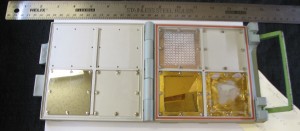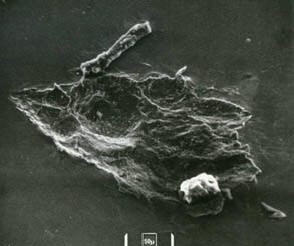From the Collection: Gemini S-10 Particle Collector

Few pieces in our collection have traveled as far as this one, or seen quite so much. This is the S-10 Particle Collector, from the Gemini space program.
How Dudley went from building observatories and looking through telescopes to building particle collectors and looking through electron microscopes is a story that deserves its own post. Suffice it to say that under Director Curtis Hemenway, Dudley hitched its wagon to NASA and the space race, then started creating things like this collector.
The S-10 was a micrometeoroid collector, meaning that it was intended to capture very small meteoroids in the very upper edges of the earth’s atmosphere. The device would be launched into space. At a certain point an astronaut would open it like a book – you can see the hinge in the middle – and the various surfaces inside would be open to whatever chose to bombard them. After a time it would be closed, prevented any terrestrial particles from getting inside when it was returned to earth.
The goal was to catch very small particles, sometimes called “space dust”. In this case, the S-10 collector was attached to an Agena Target Vehicle (ATV), an unmanned spacecraft launched as part of the Gemini space program. The ATV provided a number of different services for the Gemini capsule, such as help with maneuvering, acting as something to dock with and providing a platform for devices like the S-10.

The Gemini program was doing something that no one had imagined doing just decades before, so there’s little surprise that it was beset by problem. The Dudley’s micrometeorite program didn’t escape those problems.

Agena Target Vehicle (ATV) from Gemini 8, courtesy of NASA
This S-10 was mounted on the ATV for mission Gemini 8. When the Gemini capsule docked with the ATV, pilots Neil Armstrong and David Scott noticed that the combined crafts were entering an uncontrolled spin. After disengaging and trying to correct, the Gemini 8 capsule was forced to return to earth far sooner than expected.
Gemini 9 had an ATV of its own with a particle collector. But the shroud that protected the ATV during launch failed to detach, so the collector was never recovered.
Gemini 10 managed to retrieve the S-10 collector from the Gemini 8 ATV. Pilot Michael Collins successfully left the capsule and performed an Extravehicular activity (EVA) which took him to the Gemini 8 ATV, becoming the first person to travel from vehicle to vehicle in space.
Gemini 12 also had an S-10, but it was left on the ATV to record the results of long exposure and never retrieved.
This S-10 may be the only one that made it back to earth. It is now on display in the museum’s gallery, in a case to the left of the door to the Suits-Bueche Planetarium, along with a number of other devices for collecting and retrieving space dust created by the Dudley Observatory.
